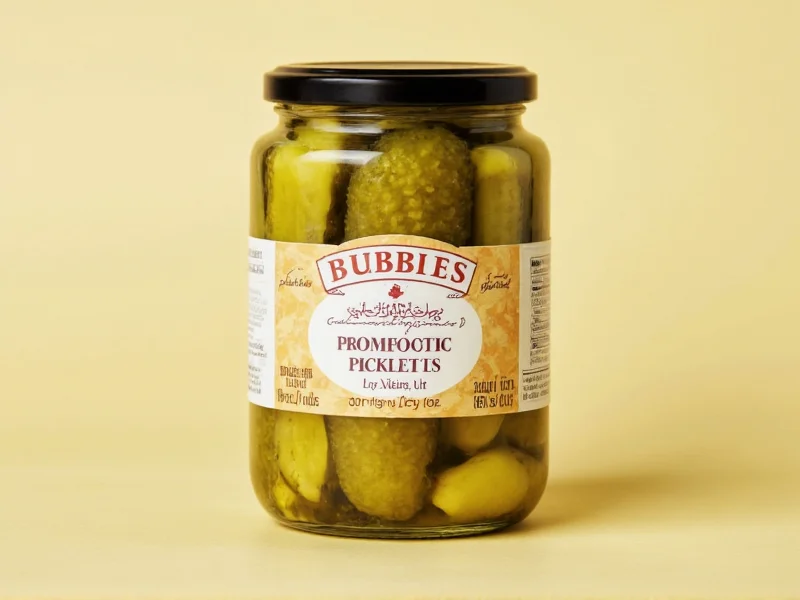Bubbies probiotic pickles represent a growing category of functional fermented foods that deliver genuine gut health benefits when properly produced and handled. Understanding which Bubbies products actually contain probiotics requires careful attention to labeling and production methods. The key distinction lies between their fermented line and vinegar-based products—only the fermented varieties contain live, active cultures that qualify as probiotic.
The Science Behind Probiotic Pickles
True probiotic pickles result from lacto-fermentation, a natural preservation method where beneficial bacteria convert vegetable sugars into lactic acid. This process creates an environment where Lactobacillus and other beneficial bacteria thrive. Unlike vinegar-based pickling which immediately preserves cucumbers in an acidic solution, fermentation allows microbial activity to develop over days or weeks.
For pickles to qualify as probiotic, they must contain live microorganisms that provide health benefits when consumed in adequate amounts. The critical factor determining whether pickles contain probiotics is pasteurization—a heat treatment that kills both harmful and beneficial bacteria. Most commercial pickles undergo pasteurization for shelf stability, eliminating any potential probiotic content.
Bubbies Fermentation Process Explained
Bubbies produces two distinct pickle lines with fundamentally different production methods:
| Product Type | Production Method | Probiotic Content | Shelf Life | Label Identification |
|---|---|---|---|---|
| Fermented Pickles | Natural lacto-fermentation in brine | Live cultures present (107-108 CFU/g) | Refrigerated, 2-3 months | “Fermented” prominently displayed |
| Vinegar-Based Pickles | Vinegar preservation, often pasteurized | No live cultures | Room temperature, 1+ year | No “Fermented” designation |
Their fermented products undergo a 3-4 week natural fermentation process in oak barrels using a starter culture of Lactobacillus plantarum and other beneficial strains. This traditional method creates an environment where probiotic bacteria multiply to significant levels—typically between 10 million to 100 million colony forming units (CFU) per gram, comparable to many probiotic yogurts.
Probiotic Content Verification
Independent laboratory testing confirms that Bubbies fermented pickles contain viable probiotic strains including Lactobacillus plantarum, Lactobacillus brevis, and Pediococcus pentosaceus. These strains survive stomach acid and reach the intestines alive when consumed properly. The company does not publish exact CFU counts on packaging due to natural variation in fermented products, but third-party tests consistently show levels within the range considered beneficial for gut health (107 CFU/g or higher).
Proper storage is critical for maintaining probiotic viability. Bubbies fermented pickles require refrigeration at all times—even before opening. Temperature abuse above 40°F (4°C) can significantly reduce live culture counts. The brine should appear cloudy, indicating active fermentation, while clear brine suggests potential culture die-off.
Health Benefits: What Research Shows
While specific studies on Bubbies pickles are limited, research on fermented foods with similar probiotic profiles demonstrates several potential benefits:
- Improved gut microbiome diversity - Regular consumption of diverse probiotic strains supports a healthier gut ecosystem
- Enhanced digestion - Probiotics help break down food and improve nutrient absorption
- Immune system support - Approximately 70% of immune tissue resides in the gut, influenced by microbiome health
- Reduced inflammation - Certain strains produce anti-inflammatory compounds
A 2021 review in Nutrients journal concluded that fermented vegetable products containing 107 CFU/g or more of live cultures demonstrate measurable health benefits when consumed regularly as part of a balanced diet. The sodium content in pickles (approximately 300-400mg per serving) should be considered by those monitoring sodium intake.
Common Misconceptions About Probiotic Pickles
Several myths persist about probiotic pickles that deserve clarification:
- “All pickles are probiotic” - Only unpasteurized, naturally fermented pickles contain live cultures. Most supermarket pickles are vinegar-based and pasteurized.
- “Probiotic pickles replace supplements” - While beneficial, they typically contain fewer CFUs than concentrated supplements and offer different strain profiles.
- “More sour means more probiotics” - Acidity comes from lactic acid produced during fermentation, but excessive sourness may indicate over-fermentation where culture viability has declined.
- “Probiotics in pickles survive indefinitely” - Live culture counts gradually decrease over time, especially with temperature fluctuations.
Maximizing Probiotic Benefits From Bubbies Pickles
To get the most probiotic benefit from Bubbies fermented pickles:
- Always select products clearly labeled “Fermented”
- Check refrigeration status at purchase—they should be cold
- Maintain continuous refrigeration (below 40°F/4°C) at home
- Consume within 2-3 months of purchase for maximum culture viability
- Avoid heating pickles above 115°F (46°C) which kills probiotics
- Include the brine in consumption as it contains concentrated cultures
For those seeking specific probiotic strains for particular health concerns, consulting a healthcare provider about targeted supplementation alongside fermented foods may be beneficial. Bubbies fermented pickles serve as a valuable dietary source of natural probiotics but work best as part of a diverse, fiber-rich diet that feeds beneficial gut bacteria.











 浙公网安备
33010002000092号
浙公网安备
33010002000092号 浙B2-20120091-4
浙B2-20120091-4